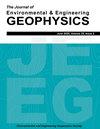Research on Pseudo-2D Joint Inversion of TEM and CSAMT Based on Well Log Constraint
IF 0.7
4区 工程技术
Q4 ENGINEERING, GEOLOGICAL
引用次数: 4
Abstract
The transient electromagnetic method (TEM) and controlled-source audio-frequency magnetotellurics method (CSAMT) are commonly used in detecting water abundance of rock formation and faults in coal mines. However, these methods show low accuracy, given the multiplicity of their inversion results, especially for areas with minor differences in lithology and electrical property. To improve the accuracy of electromagnetic exploration, a pseudo-2D joint inversion is performed. The objective function of this pseudo-2D joint inversion is established, and the joint inversion process is constrained by resistivity logging data. Afterward, the symmetric successive over-relaxation (SSOR) is used to realize the pseudo-2D joint inversion calculation of TEM and CSAMT with well log constraint. The effectiveness of joint inversion is verified by combining synthetic and field data. Results show that the pseudo-2D joint inversion results of TEM and CSAMT with well log constraint correspond to the actual geological situation. Compared with either TEM or CSAMT, joint inversion has a significantly better capability of reflecting water abundance in rock formation and faults.基于测井约束的瞬变电磁法与CSAMT伪二维联合反演研究
瞬变电磁法(TEM)和可控源音频大地电磁法(CSAMT)是煤矿地层和断层水丰度探测的常用方法。然而,考虑到反演结果的多样性,这些方法的精度较低,特别是在岩性和电性差异较小的地区。为了提高电磁勘探精度,进行了伪二维联合反演。建立了拟二维联合反演的目标函数,联合反演过程受电阻率测井资料约束。随后,利用对称逐次超松弛(SSOR)实现了具有测井约束的瞬变电磁法和CSAMT的伪二维联合反演计算。通过综合资料与现场资料的结合,验证了联合反演的有效性。结果表明,具有测井约束的瞬变电磁法与CSAMT伪二维联合反演结果符合实际地质情况。与瞬变电磁法和CSAMT相比,联合反演在反映地层和断层中丰度的能力明显更好。
本文章由计算机程序翻译,如有差异,请以英文原文为准。
求助全文
约1分钟内获得全文
求助全文
来源期刊

Journal of Environmental and Engineering Geophysics
地学-地球化学与地球物理
CiteScore
2.70
自引率
0.00%
发文量
13
审稿时长
6 months
期刊介绍:
The JEEG (ISSN 1083-1363) is the peer-reviewed journal of the Environmental and Engineering Geophysical Society (EEGS). JEEG welcomes manuscripts on new developments in near-surface geophysics applied to environmental, engineering, and mining issues, as well as novel near-surface geophysics case histories and descriptions of new hardware aimed at the near-surface geophysics community.
 求助内容:
求助内容: 应助结果提醒方式:
应助结果提醒方式:


